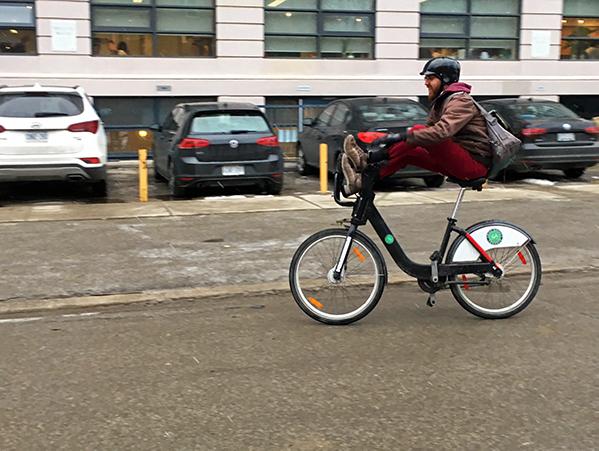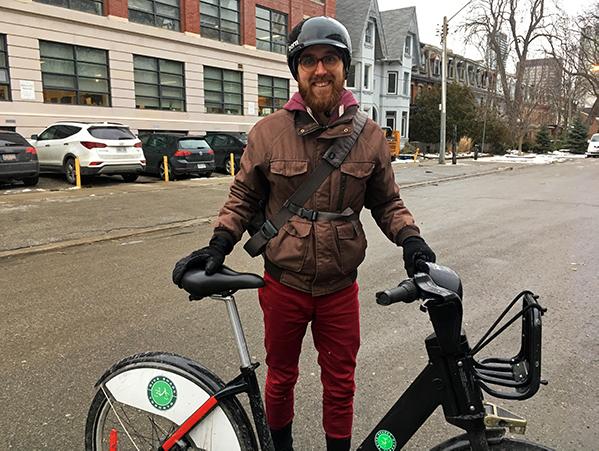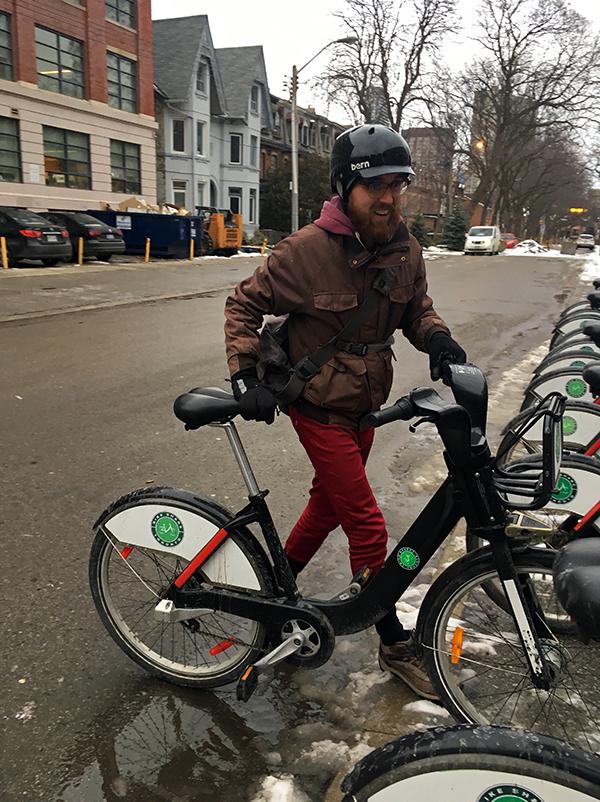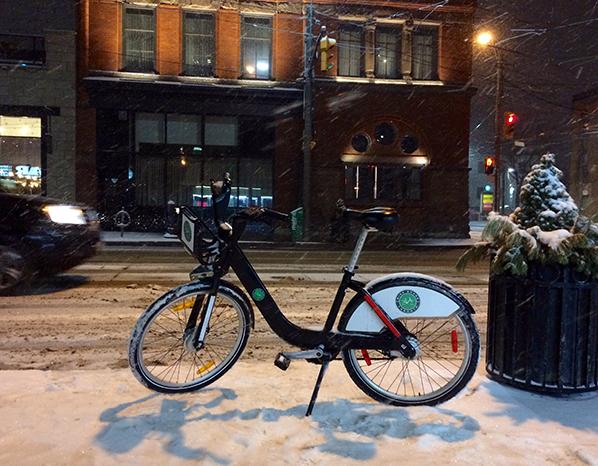
#bikewinterview: Jay's daily dose of pedalling

Read on to find out how Jay, founder of RallyRally (a design studio dedicated to social change), navigates Toronto’s streets by Bike Share - and why getting a daily dose of pedalling is crucial to his physical and mental wellbeing. Plus, he offers head to toe tips on dressing to ride in comfort, even on the slushiest of days.
Tell us about your typical commute.
Throughout the year, I get around Toronto mainly by bike, though I also walk and use transit. Most often I ride from home near Broadview and Danforth to my office at Queen and Spadina, which takes about 20 minutes. I also bike around downtown and the east end for meetings, errands, and social events. I ride on most days in the winter, but I look out for bad weather conditions. I give myself permission to take transit when I need to, like if there is freezing rain, a lot of wet snow, or if the roads haven’t been properly cleared following a snowstorm. Our infrastructure unfortunately isn’t good enough to comfortably ride every single day.
Why do you ride in the winter?
I ride all year round because it’s just the most economical way of getting around the city. It’s relatively low-cost, even owning my personal bike and having an annual Bike Share membership – it’s way cheaper than buying a monthly Metropass. I also care about minimizing my carbon footprint. Cycling puts me in control of my commute, as I can avoid traffic jams and transit delays, and it’s the fastest way to go from point A to B for most trips. Another reason I ride is for health: since I run a design studio, I spend a lot of time at my desk. An active commute is an easy way to inject 40 minutes of cardio exercise into my daily routine, which is helpful for physical and mental health, especially in the dark of winter.
You often use Bike Share in the winter, even though you own a bike. Can you tell us about that?
I have a Bike Share membership and it’s a great supplement to owning a bike. I ride my own road bike most of the time in spring, summer, and fall. It’s super fun to ride, but it’s a single-speed with skinny tires and isn’t ideal for winter riding.
So in the winter, I use Bike Share almost exclusively. The bikes have wide, sturdy tires, which prevents sliding around when the conditions are snowy or icy. The fenders keep me dry. The gears and brakes are reliable, even in bad weather. I can keep my hands warm when docking the bike as there’s no need to fiddle around with a lock and key. Most importantly, I can avoid salt and slush damage to my own bike and I don’t have to spend time wiping off my bike when I get home. It’s also about flexibility. Bike Share allows me to switch between biking and TTC if the road conditions change in between my morning and evening commutes, which happens often!
How does your riding change in the winter?
With winter riding, I find the cold isn't really an issue – generally riding in temperatures above -10C is pretty comfortable. It's the road conditions that can make winter riding a challenge. Even with Bike Share, there are days (typically the first day or two after a heavy snowfall) when I don't feel safe to bike because the roads are covered with snow, slush, or ice. When that’s the case, I take transit until the bike lanes are cleared.
I also choose different cycling routes in the winter. In the summer, I use shortcuts, like laneways and quiet side streets. In the winter, these aren’t ploughed very often. With snowy road conditions, I stick to more open streets where I can see what's coming, as I can’t turn or brake as suddenly. It often takes a couple of days after a big snowfall for side streets to be cleared. Even if it’s hard packed snow, there might be ice hiding underneath. I wish the road conditions were more predictable.
I actually find the fall season to be more dangerous, especially with wet leaves covering sewer grates. So it’s important to know about these hazards regardless of the season.
Cycling isn’t inherently dangerous. We need the City to dedicate resources to building and maintaining safe cycling infrastructure across the city, like:
-
The Prince Edward Viaduct (linking Bloor Street and the Danforth): the City removes the bollards in the winter and the bike lane is often partially or completely uncleared, with snow buildup effectively eliminating the bike lane. With drivers travelling at high speeds along the Viaduct, I feel vulnerable with cars almost brushing my elbows.
-
St. George, College, and Harbord Streets: I often encounter cars parked halfway into the bike lane due to snow accumulation along the curb.
-
Bloor Street in front of the Royal Ontario Museum: even though there is a bike lane, it’s a mess of potholes; in the winter, they can be filled with slush or water, making them even more precarious to navigate.
What’s one tip you’d share with someone new to winter biking?
Number one: don't overdress! Check the weather throughout the day and dress accordingly. It’s easier than you’d think to keep your core warm once you get moving; layering is a great way to dress for changing weather conditions (see tips below). Secondly, allow yourself some extra time so that you can ride slowly if needed. And thirdly, Bike Share is a good option for trying out winter biking! If the road conditions become too challenging, you can always dock the bike and hop on transit or walk the rest of the way.
Top winter riding accessory or bike part?
There's no silver bullet, but I’d say overall, wear lots of thin layers so you have the flexibility of adding or removing layers as temperatures change. I often ride with a large enough messenger bag to stash an extra layer. From top to bottom, I’d recommend the following:
-
A winter helmet with just a few ventilation holes on top (I have a Bern helmet from Sweet Pete’s).
-
A thin toque, plus a bandana to tie like a headband to cover your ears.
-
A long-sleeve shirt under a windbreaker jacket.
-
Arm warmers are a good way to keep cold air from entering your jacket sleeves around your wrists. Easy hack: cut the feet off an old pair of socks to make arm warmers.
-
If it’s really cold out, add a down vest under your jacket and long johns as an extra bottom layer.
-
To keep my hands warm, I wear lobster gloves (which you can find at MEC) and sometimes add an extra layer of thin gloves underneath.
-
Warm, waterproof but lightweight boots that allow enough agility for pedalling.
-
An extra pair of socks; again this is easy to tuck into your bag, or keep a pair at work.
What’s one myth you’d like to dispel about winter biking?
That it's too cold to bike in the winter! You don't have to be a hardcore cyclist to bike year-round. Just dress appropriately and give yourself permission to use other modes of transit when the road conditions are exceptional. It doesn’t have to be all or nothing.
Got a winter biking tip to share? Celebrating #WinterBiketoWork Day? Tell us, and tag us in your photos!




